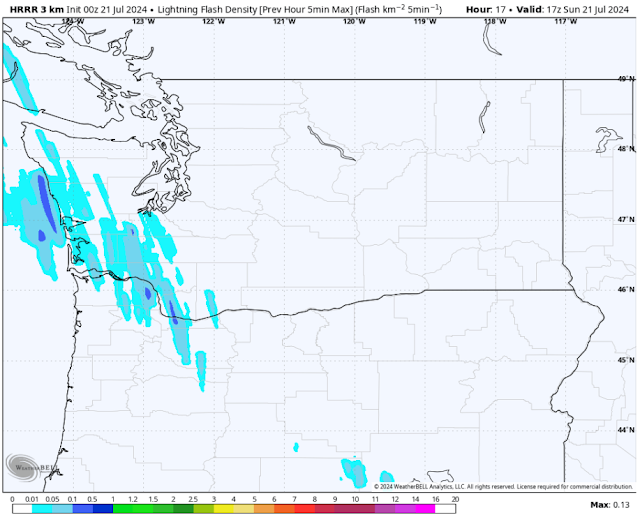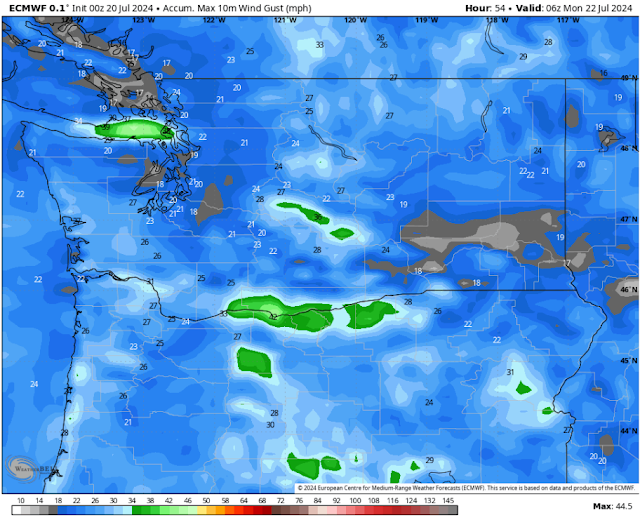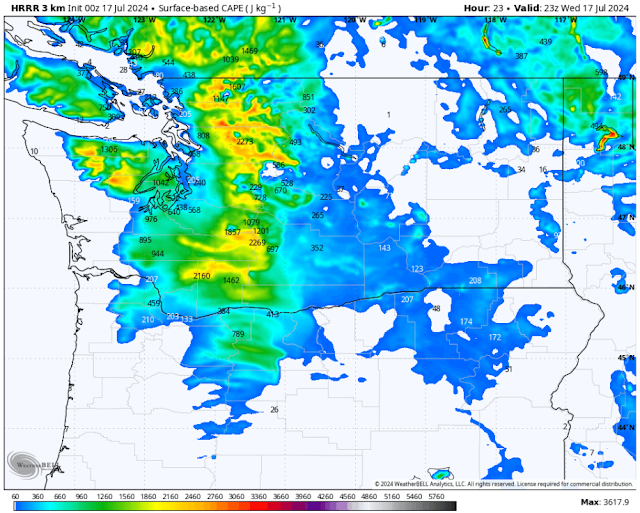FastCast--Monday, July 29 to Thursday, Aug. 1:
After weeks of mostly dry conditions, rain is returning to Western Washington on Monday. However, it won't be enough to put out any wildfires across the region. Expect rain at times from early Monday morning through the evening, turning showery from Monday night through Tuesday. In the lowlands, amounts of 0.15-0.5" are expected, most from Seattle northward due to rain-shadowing from the Olympic Mountains. Areas from Everett northward and on the coast will receive 0.4-0.8". The western slopes of the Cascades will likely receive 0.5-1.5" of rain, most from Snohomish County northward. This rain will decrease sharply from the crest of the Cascades and eastward, with forecasts predicting under 0.15" for major wildfires in Eastern Washington. Temperatures will be noticeably cooler across the region on Monday, with highs only reaching the mid to upper 60s. Tuesday will see a warmup to the upper 60s to low 70s, followed by decreasing clouds and highs in the mid 70s to low 80s on Wednesday. Mostly sunny conditions are expected on Thursday as well, with highs increasing to the upper 70s to mid 80s. A very warm Seafair weekend is possible, so stay tuned.
Click here for my video from the Retreat Fire (near Naches, WA) on July 27, 2024 (includes interview with fire Public Information Officer).
----------------------------------------------------------------
Continue reading the full blog below!
Rain is returning to Western Washington! Ironically, this will be happening on the driest day of the year (statistically), with rain on July 29th only 4 times since 1945. The record of 0.17" in Seattle will likely be broken, although forecasts vary on the actual rain amounts. Let's take a look at the forecast!
We'll start with the forecast from the NWS NBM high-resolution model, seen below.
This forecast shows a rain shadow SW of the Olympics, including most areas from Everett southward. This rain shadowed region will get 0.1-0.3" of rain, while areas from Everett northward and on the coast receive 0.4-0.8". The west slopes of the Cascades will receive 0.5-1.5". However, wildfires on the east slopes of the Cascades (Pioneer & Retreat Fires) will only receive 0-0.15" in this forecast.
Next, let's compare this to the more ambitious European model forecast, seen below.
This forecast shows much less rain shadow impacts, with the lowlands getting 0.3-0.5", areas from Everett to Mount Vernon getting 0.5-0.9" due to Convergence Zone activity on Tuesday, and the coast getting 0.5-1.1". The western slopes of the Cascades get 0.5-1.8", and the Pioneer & Retreat Fires get 0.05-0.15".
While this rain will be short-lived, with showers coming to an end by Tuesday, it will provide necessary temperature, cloud cover, and humidity-related relief for wildfires across the state.
Temperatures will be noticeably cooler on Monday than on any previous day as of late. Below is the NWS NBM forecast for Monday's highs.
On Monday, lowland highs will only reach the mid 60s, while the coast reaches the low to mid 60s. The Willamette Valley will reach the low to mid 70s, and Eastern Washington will cool to the upper 70s to mid 80s.
Tuesday will be a bit warmer across the state, seen below.
On Tuesday, expect lowland highs in the upper 60s to low 70s, with coastal highs in the mid to upper 60s, and Willamette Valley highs in the upper 70s to low 80s. Eastern Washington will warm to the mid to upper 80s, although some areas will remain in the upper 70s to low 80s.
By Wednesday, noticeable warming is observed across Washington.
On Wednesday, expect lowland highs in the mid 70s to low 80s, with coastal highs in the mid 60s to low 70s, and Willamette Valley highs reaching the mid 80s to low 90s. Eastern Washington will warm to the upper 80s to low 90s.
Let's take a look at the European Ensemble's extended forecast for Seattle, showing possible temperatures over the next 2 weeks.
Notice a significant warmup after the rain moves through, with potential for quite a warm Seafair weekend, with highs in the mid to upper 80s (or warmer) possible.
Stay tuned, as there's a lot to nail down in the forecast over the next few days!



















































